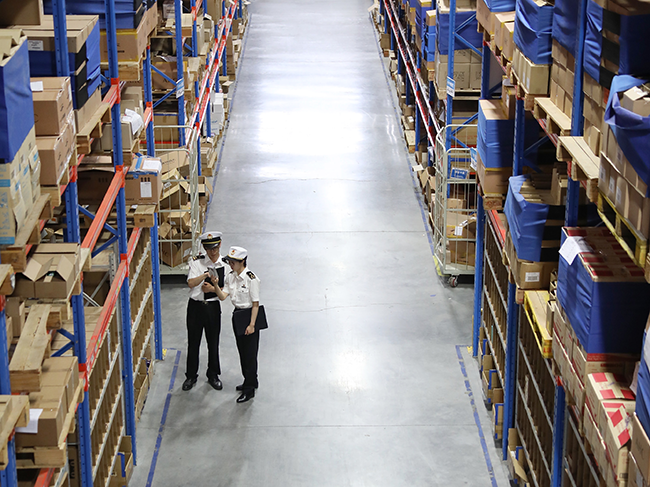The e-commerce supply chain is both data-rich and data-driven. In this article, China Customs outlines how it is harnessing the digital nature of the e-commerce sector in order to strengthen its monitoring and enforcement capabilities.
The WCO defines cross-border e-commerce as “All transactions which are effected digitally through a computer network (e.g. the internet) and result in physical goods flows subject to Customs formalities.”[1] In the context of China Customs, cross-border e-commerce imports refers specifically to retail goods that are purchased by consumers within China Customs territory from online platforms or sellers located outside that territory and are shipped to those consumers via postal services or express couriers.
All cross-border e-commerce import transactions must meet the following conditions:
- the goods concerned must be on the List of Cross-Border E-Commerce Retail Imported Goods and must be intended strictly for personal use;
- transaction data must be transmitted through the IT systems of e-commerce platforms or vendors that are linked to China Customs’ IT system; failing that, express and postal operators may be authorized to transmit key data (e.g. transaction and payment information) to Customs – they will then bear the corresponding legal responsibility;
- importation must follow one of two approved models:
- direct import: consumers in China place online orders with overseas sellers; parcels are shipped directly to the consumers, undergoing import Customs procedures upon arrival in China;
- bonded import: e-commerce platforms or vendors pre-stock goods in bulk in bonded warehouses or special Customs supervision zones (Type B) in China; these goods are processed as parcels and released through Customs only after domestic consumers place orders online.
Under the two import models for cross-border e-commerce goods mentioned above, the de minimis threshold for VAT and consumption tax has been eliminated, and Customs duties are waived for individual goods valued below RMB 5,000. The Chinese Government also imposes limits on the value of individual transactions and the total annual value of cross-border e-commerce purchases per domestic consumer. In contrast, personal shipments sent via express or postal services that do not involve electronic data transmission to Customs are treated differently. These are classified as imported personal postal articles, and a separate tax policy applies, with duties and taxes assessed accordingly.
Harnessing a data-rich environment
China’s E-Commerce Law, in effect since 2019, stipulates that “cross-border e-commerce operators may complete relevant procedures with national import and export administrative departments using electronic documents”. This legislative framework has enabled the e-commerce supply chain in China to become both data-rich and data-driven.
China Customs has taken advantage of this digital environment to enhance its ability to monitor, assess and regulate cross-border e-commerce, while remaining aligned with the WTO Trade Facilitation Agreement and the WCO Framework of Standards on Cross-Border E-Commerce.[1] The latter calls on Customs administrations to “develop and apply dynamic risk management with advanced technologies that are specific to the E-Commerce context to identify goods and shipments that present a risk”.
Since 2020, the seizure rate for high-risk shipments identified through real-time screening has reached 21.9%, nearly 100 million pieces of data have been analysed, resulting in the compilation of a blacklist of key individuals and companies involved in suspicious activities, and seven major smuggling cases related to e-commerce have been investigated. These efforts have helped safeguard the rights and interests of legitimate e-commerce businesses and consumers, while promoting the healthy and sustainable growth of the cross-border e-commerce sector.

Automated “three-list matching” approach
To enhance oversight of e-commerce transactions, China Customs requires all relevant parties to transmit order-related data electronically via the China Single Window platform. This involves three key types of data – or “lists” – for each transaction: the order list, the payment list and the logistics list.[2] Some data elements are mandatory, while others are optional. The e-vendor, e-platform or designated express carrier is responsible for transmitting the order data; the payment service provider, express carrier or postal operator is responsible for submitting the payment list; and the logistics provider is responsible for submitting the logistics list. China Customs’ system automatically cross-references and verifies the consistency of these three lists to ensure the authenticity and accuracy of the transaction.
Preventing identity fraud
To combat fraud involving stolen consumer identities used to buy and resell goods for profit, China Customs conducts consumer identity verification for high-risk imports. These are typically transactions flagged for potential under-valuation or false transactions. Consumers are required to log into the China Customs mobile app or the Single Window platform to complete an identity authentication process, confirm the transaction and submit proof of payment. The payment data are then matched against information from the payment service provider to verify legitimacy.
Big data analytics platform
To strengthen its ability to monitor e-commerce transactions, China Customs has implemented a big data analytics platform that collects and stores data from postal operators and express couriers. Using analyses various transaction elements, including buyer and seller information, company records, shipping addresses and product types. the Administration has developed real-time risk monitoring models covering a variety of risks.
Through the study of past seizures and fraud cases, China Customs has created revenue and security risk indicators. This has led to the development of a risk control mechanism based on data analysis and cross-referencing. The system also profiles high-risk individuals and companies, and compiles lists of sensitive commodities that are often undervalued or smuggled.
Smart image reading system
Postal operators and couriers are required either to scan all processed parcels using an X-ray machine and transmit the resulting images and data to Customs or to set aside parcels specifically flagged by Customs for further inspection. These selected parcels are then X-rayed. To improve its image analysis capabilities, China Customs has developed an automated support system for image analysts, using automated target recognition (ATR) algorithms. This system is trained to detect narcotics, prohibited animal and plant species, firearms and ammunition, goods likely to infringe intellectual property rights, and other restricted or suspicious items. The information derived from the image analysis is automatically cross-checked with the declaration data for discrepancies.
Customs WeChat official account
WeChat, China’s most widely used messaging and social networking app, offers official accounts for organizations to connect with users, share content and provide services. China Customs has launched a pilot official account to request identity verification from individuals and to ask follow-up questions related to their online purchases. This initiative helps Customs verify the authenticity of declarations submitted by enterprises suspected of illicit activities.
Under its official WeChat account “Customs Release”, China Customs has developed a mini programme that enables consumers to access regulatory information on cross-border e-commerce, view their transaction history, track their total consumption amount and check the status of tax payments.
Connecting e-vendors, Customs and banks in a digital ecosystem
To streamline revenue collection, China Customs employs an intermediary collection model. At the point of order, intermediaries (such as e-commerce platforms and e-vendors, logistics providers or Customs brokers) collect the pre-assessed duties and taxes from the consumer along with the payment for the goods. Consumers may return goods within 30 days of the release of the goods and receive a full refund including taxes and duties. After the refund window closes, the intermediary makes a consolidated tax payment to Customs. Because goods are released before the tax payment is confirmed, a bond is required in advance. Once duties and taxes are fully paid, the bond is refunded to the intermediary’s account.
Using the Single Window platform, China Customs connects e-vendors, Customs and banks in an integrated digital ecosystem, allowing online payment of taxes and duties, efficient refund management and reduced paperwork and administrative burden for businesses.
Ensuring the quality and safety of goods through information sharing among stakeholders
Cross-border e-commerce goods originate from a wide range of suppliers and are more likely to fall short of domestic quality and safety standards. To address this concern, China Customs has established a Monitoring Centre and a National Risk Assessment Centre for Cross-Border E-Commerce Commodity Quality and Safety.
To develop its automated risk analysis capabilities in this area, China Customs draws on a variety of data sources, including:
- historical monitoring and risk assessment results conducted by Customs;
- results from Customs-led quality and safety testing of products;
- self-testing reports provided by e-vendors;
- updates on technical regulations and product quality and safety alerts issued by national and international authorities;
- negative media reports – both national and international;
- consumer complaints and negative product reviews posted on e-commerce platforms;
- information shared by other government agencies;
- reports of problematic products or consumer complaints filed with market surveillance authorities.
If a good is found not to be safe, China Customs issues early warnings to the public via its official WeChat account and shares relevant risk information with stakeholders such as e-commerce platforms, postal operators, couriers and local regulatory authorities through established communication channels.

China Customs has signed quality co-governance cooperation memoranda with major e-commerce platforms. These agreements require platforms to integrate product quality and safety control measures into their operational workflows, and take immediate risk mitigation actions upon receiving Customs notifications regarding defective or hazardous goods.
One example involved a specific brand of strollers that repeatedly received complaints about quality and safety issues but continued to be available for sale. In response, China Customs launched a targeted risk monitoring campaign focused on the stroller category, including this particular brand. Customs sampled stroller products from cross-border e-commerce platforms and bonded warehouses, and conducted safety testing of the samples. The test results showed that one stroller (brand Y) from country X met that country’s standards but failed to comply with China’s mandatory national safety standards. Specifically, the headrest gap was too wide to be considered safe for newborns. A panel of experts classified the product as high risk, citing the danger of head entrapment, falls and serious injury. As a result, China Customs notified relevant e-commerce platforms of the risk, recommending immediate removal of the product from online shelves and technical rectification of the product design. The product will be allowed back on the market only once it passes re-inspection and meets all regulatory requirements.
Strengthening cooperation with international partners
China Customs actively contributed to the development and revision of the WCO Framework of Standards on Cross-Border E-Commerce, providing detailed and up-to-date explanations of its regulatory practices in the WCO E-Commerce Compendium. As part of the EU-China Joint Customs Cooperation Committee (JCCC), China Customs is also engaged in ongoing dialogue with EU Customs authorities on the regulation of cross-border e-commerce. The Administration remains committed to sharing its experience and best practices to help improve regulatory efficiency and service delivery, thereby supporting the growth of high-quality, standardized cross-border e-commerce.
[1] Tools supporting the implementation of the Framework – “Definitions”: https://www.wcoomd.org/en/topics/facilitation/instrument-and-tools/frameworks-of-standards/ecommerce.aspx
[2] The WCO Framework of Standards on Cross-Border E-Commerce, which provides 15 baseline global standards, states that a “legal and regulatory framework should be established for requiring advance electronic exchange of data between relevant parties involved in the E-Commerce supply chain, and Customs administrations and other relevant government agencies”.
[3] The list of the data elements can be found in the WCO E-Commerce Compendium.